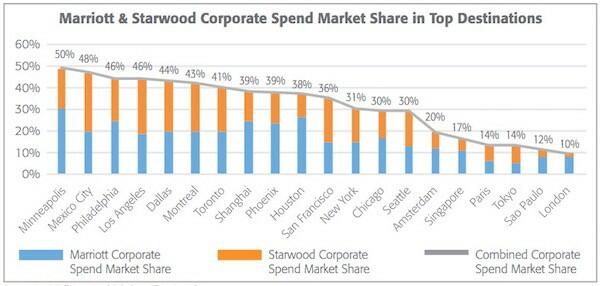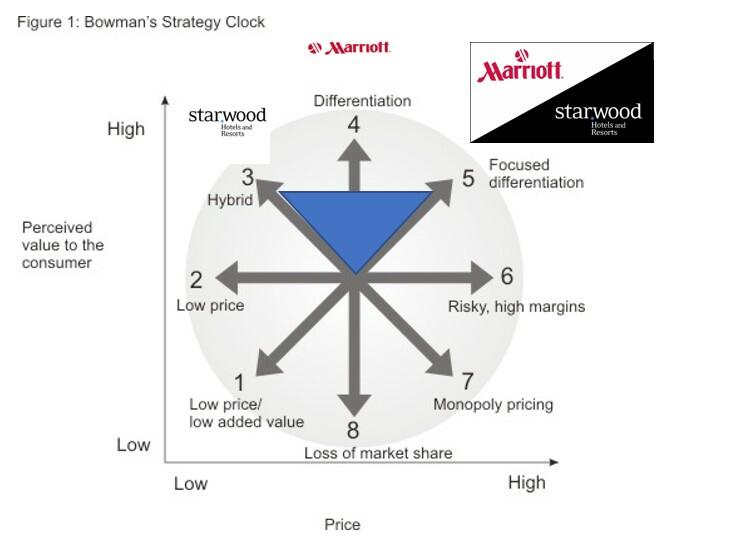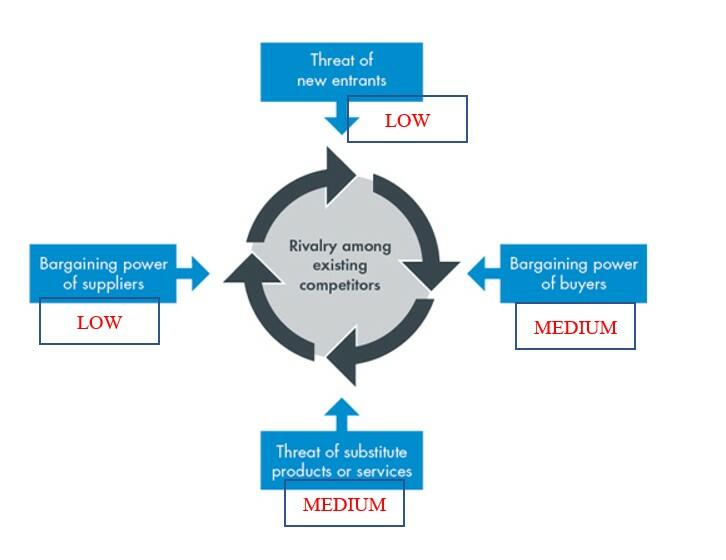Introduction
In 2016, after years of negotiation Starwood Hotels accepted the highest offer by Marriott International for $13.6 billion. The merger of the two global hotel and resort chains would create the biggest chain of 5,500 hospitality facilities in over 100 countries. Starwood was approached strongly by Anbang, a Chinese-led consortium, but eventually the Starwood board decided to accept Marriott’s proposal (Wood, 2016). The course of action is considered strategically beneficial for both companies that would ensure long-term value for its equity. This report will investigate the relevant aspects of the merger including strategy, portfolio, stakeholders, as well as industry and market analysis that outline the key business benefits for the continuation of this merger.
Relevant Levels of Strategy
Company Backgrounds
Marriot represents a full-service chain of hotels and resorts with over 500 locations globally. Their mission is “to enhance the lives of our customers by creating and enabling unsurpassed vacation and leisure experiences” (Sorbello, n.d.). The majority of Marriott’s market share prior and post-merger was in the U.S. where the corporation generates more than 80% of its profits. The chain also manages Marriott Vacation Club International which includes over 50 resorts worldwide. The Marriott brand appeals mostly to mid-class and business consumers with its well-known Courtyard brand. In the late 1990’s Marriott began entering the luxury market by acquiring the Renaissance and Ritz Carlton hotel brands but remained a relatively small player in this segment.
Meanwhile, Starwood represents the category of exclusive luxury appealing to the upper-class market segment. This is the only segment that Starwood has ever operated in, building them a strong reputation in the market is a high-class luxury provider. Starwood owned a number of luxury brands such as Ritz, Sheraton, and Le Median among others. While only having approximately 1000 properties worldwide, they had a presence in more than 100 countries. Despite global economic fluctuations, Starwood remained strong in the upscale sector of the economy, mostly due to its business connections with brands such as Mastercard, Coca Cola and others which were helpful in providing their customers with the unique luxury experience (Starwood corporate overview, 2016).
Corporate Level Strategy
Corporate strategy can take on three distinct directions: growth, stability, and renewal. Growth consists of expanding the number of markets that the company serves through current or new businesses. Stability indicates following the status quo and pursuing its current strategy and operational plan, focusing on the same customers and markets. Finally, renewal is commonly activated when an organization is struggle and it requires a complete turnaround in terms of strategy to address declining performance (Mahajan, Mahajan, & Dewan, 2016).
The merger between Marriott and Starwood can be labelled as growth from a corporate management standpoint. It allows Marriott to expand its presence in the luxury sector of hospitality, acquire new properties in a variety of global markets, and overall boost its property and service portfolio. Following this merger, Mariott has announced in 2019 that it will pursue an aggressive three-year growth plan adding more than 275,000 rooms, and between $400 and $700 million in revenue.
The reason Marriott is pursuing this is due to the Starwood acquisition which the company notes made them a “formidable competitor” in the sector with a valuable loyalty program, strong appeal, and presence in new markets such as the Asia Pacific region (Marriott International announces three-year growth plan, 2019). This growth provides economies of scale and cost synergies that provide opportunities for Marriott to build on its market positioning and strengths.
Market Targeting and Segmentation
Marriott International appeals to a broad range of market segments, ranging from mid to upper range offerings of hotels and resorts. Marriott owns moderate tier brands such as Courtyard and SpringHill Suites as well as some lower level offerings at Fairfield Inn. Marriott has been able to be successful by increasing efficiency and keeping costs down by adopting latest sustainability practices and technologies. It is also appealing to a wide range of consumers, while maintaining a reasonable profit margin (A.W., 2016). Corporate travel is the largest and most profitable market segment that most hotel chains strive to acquire.
With the Starwood merger, the combined chain will now attract a significant portion of corporate spending in the world’s largest urban cities, reaching almost half the market share in some areas as demonstrated on the graph below.

Business Level Strategy
Porter’s three generic strategies of cost leadership, differentiation, or focus are potential business strategies that a company can undertake to achieve a competitive advantage in its core market via the means of either lower cost or differentiating itself and thus commanding a higher price for its services (Islami, Mustafa and Latkovikj, 2020). Marriot seeks to differentiate itself and not undercut its competition through pricing, that was the main purpose of merging with Starwood.
The acquisition of Starwood as well as the earlier introduction of the Ritz Carlton and Autograph Collection luxury brands to the chain, Marriott is attracting customers that would pay for premium packages and services for high-end accommodation. At this level, it is critical for the brand to maintain cutting edge quality of service in order to remain competitive, thus the purchase of the brands that offer a variety of tastes and experiences along with services that standalone hotels do not offer, such as golf courses.
In turn, this quality of services and availability of facilities trickles down to Marriott’s mid-range offerings as well and provides opportunities for members to experience high-end amenities through reward programs that will be shared and interchangeable among all of its branches. Marriott’s acquisition of the Starwood brand also expands its business partnerships and credit card outreach with Chase and American Express (Whitmore, 2018). This type of business strategy helps the enterprise to balance increase in prices from suppliers and rising operating costs while differentiating them from competition.

Strategic Positioning-Bowman’s Strategy Clock
As seen in the figure above, the blue triangle represents the positioning of Marriott, Starwood, and their combined brands before and after the merger. Position 3 was taken by Starwood prior to the merger, representing a blend between low prices for its segment and product differentiation. Marriott took upon Position 3 as well but focused on Position 4, which is differentiation prior to the merger.
Utilizing its brand and high quality of services, Marriot attempted to position itself as different, building a strong recognition and customer loyalty, which it also maintained after the merger. However, after the merger, the combined companies also adopted Position 5, the focused differentiation approach. Using the strategy of perceived added value, the company positions a product or service at highest price level, which the customers are willing to pay above market cost for the return of the value distinguished from a specific brand. Marriott took some of these elements from Starwood luxury properties positioning and adopted it to the majority of its global brand.
Branding
Branding is both a concern and a benefit for this merger. There is potential for homogenization of the key brands as the merger continues and cuts are made, leading to disappearing differentiation or it being operationally negated. One franchisor, which is Marriott will now control several brands. First, it will lead to heavy-handed negotiations between owners and brands regarding brand positioning and requirements.
Furthermore, it may result in brand over-saturation in the market which will negatively impact distribution of resources and amenities. Brand loyalty will be disbursed, as guests may likely easily switch between Starwood and Marriott properties, which does not hurt the franchisor but may influence hotel owners. Brand phasing out is a threat to existing hotel properties due to the brand overlap that would now exist. It will require significant capital and time to making significant brand changes, brand conversions when necessary, and establishing consistent brand standards along with relevant marketing materials (Ritson, 2016).
Key Stakeholders
Such large consolidations between major industry players has profound impacts on the sector and its stakeholders, both associated with the companies and outside. A stakeholder is an entity that has influence over the success and decision-making of an organization as well as potentially being affected by the activity or outcome of a project.
Owners
For the owners, this merger will be highly beneficial for a few reasons. It provides significantly more decision-making influence in the hands of the organization. It also reduces competition, driving more business to the organization and diluting the competition in location where Starwood properties previously went against Marriott. Profit margins will likely see an increase and due to the market share increase, the overall net profits as well.
Employees
Employees and executive driving the operational aspects of the respective organizations will see the most change. The companies are different in some ways, as Marriott has a rigid structure and operational environment, while Starwood has a progressive and flexible culture. It is likely that the cultures will clash. The merger will create the economies of scale, but it will benefit Marriott more than Starwood, and some properties for both organizations will likely have to face unpleasant rebranding options.
Marriott has consistently been named one of the top companies to work for and has numerous loyal employees that have worked over 10 years for the company. This suggests a low turnover rate and high commitment. With the addition of more than 200,000 Starwood employees, the total number will reach almost 500,000. The employees will be welcomed and valued for their knowledge of Starwood properties. Some reshuffling and layoffs may occur, most likely at the manager and executive level.
Shareholders
While both executives and shareholders for both companies desired the merger deal, it came after months of hard negotiations. After Marriott’s offer, Anbang offered a sum of $14 billion, which Marriott had the capital to match but the share prices were already established at the level that most shareholders would not have wanted to exceed. It is likely that shareholders will be closely watching share prices and stock fluctuations as the merger goes through, and how the new conglomerate will decide to price its shares and pay dividends.
Consumers
Consumers will be affected as well. Fees and booking terms may change, not necessarily for the better. Brands and experiences may be diluted in the long-term as the merger goes through, as seen in previous mergers where Marriott essentially swallowed up the culture of Ritz-Carlton and led to the loss of its symbolic high-end perception. There will be a change on how the booking and rental services operate as well as changes to the loyalty programs. Although the companies have agreed to maintain for now their loyalty and legacy programs, there will be opportunities for cross-transferring of reward points.
Mapping Stakeholders
Industry Analysis

Supplier power
Commonly suppliers have greater bargaining power if the product is a critical important input for success in the industry. In this industry, which offers services, there are no tangible products, while there is no one source of skilled labour. However, there are online booking and travel agencies which collect a percentage profit off total bookings conducted through them. They offer opportunities for comparison of prices and amenities. Major players such as the online portal Expedia can influence client flow but ultimately it is to their benefit to collaborate with brands like Marriott to boost bookings through their website.
Buyer power
Marriott holds a strong global brand recognition that appeals to customers from different segments such as mid to upper level hotels, with the merger adding the luxury segment as well. With over 100 million unique members, Marriott’s loyalty programs have helped to build a strong dedicated client base and make accommodation facilities more affordable. Generally, buyers do not act as a bargaining power individually, but can become an influence in bulk, particularly some elements such as business travellers. However, if Marriott continues to support its brand and loyal consumers, buyer power is not a major influence.
Competitive rivalry
Competition increases when differentiation is low along with product substituting costs. Prior to the merger, Marriott International came second globally with 5.6% market share, while Starwood Hotels were at 3.4%. After the merger, Marriott became the leading global brand and its portfolio increased to operations in 122 countries and it became a leading market share holder.
Threat of substitution
One possible threat of substitution is the rising popularity of the shared economy model with companies such as Airbnb which allows users to rent a wide variety of residences ranging from apartment rooms to whole villas, across the globe. These rentals come at much cheaper rate in comparison to hotels, offer greater flexibility, and the room portfolio exceeds that offered by Marriott, making the company vulnerable in light of economic downturns (Dogru, 2019).
Threat of new entry
Threats of new entry to the sector at the level of Marriott and Starwood is virtually non-existent. Some of the lower end properties from Marriott may compete with other smaller hotel chains and private businesses, but the cost of land property and investment required for middle to high-end hospitality facilities, it is highly unlikely new competitors will emerge in the near future.
External Analysis – PESTLE
Political Factors
Political unrest or closed borders (such as with China in the coronavirus outbreak) ongoing in several parts of the world can reduce travel and significantly impact profits for locations. Transportation dangers such as crashing of the Boeing planes last year and the downing of another plane in a military conflict will create fears for travellers. All of these will decrease demand for hotels. Increased regulation or standards in certain markets for hospitality services may be impactful as well.
Economic Factors
Travel spending greatly depends on global economic growth, both for consumers and business travel. Slowing economic growth and turmoil in individual markets can potentially reduce business travel spending that Marriott heavily profits from. The increase of minimum wages in many countries around the globe including the United States will increase labour costs. However, income inequality and stagnation of middle-class wages will also impact individual buying power for consumers.
Social Factors
Travel and international spending is increasing year over year as globalization continues. Furthermore, new segments of the populations and cultures, especially the number of Chinese tourists is increasingly significantly. Average spending per household on hospitality services is also increasing, along with the demand for luxury services and amenities that Marriott now offers with Starwood.
Technological Factors
Online rental and booking portals are becoming widely used, and the technology of the booking process and payment online should be rapid and user-friendly. Technology presence in hotel rooms, such as smart assistants and connected technology will be the demand of the future, particularly for higher-end facilities. It is necessary to implement smart AI technology into the hotels and their services to improve the guest experience and increase efficiency.
Legal Factors
There are no current legal challenges against Marriott. However, legal action and increased regulation against its substitute threat Airbnb in major cities presents potential for Marriott to grow, positioning itself as the safe and legal alternative to the unregulated rental market.
Environmental Factors
Due to the global outreach of the company and overall sector, climate change and natural disasters may impact operations and profits. Tourist destinations may be affected by climate, causing a downturn in profit for some areas. Supply chains and fuel prices are also volatile to environmental influences, potentially raising prices and decreasing travel to certain destinations or creating economic barriers for various segments of travelers (Semenza and Ebi, 2019).
Conclusion
Through analysis of evidence and models, it is evident that the Marriott merger with Starwood had a strategic and economic purpose of establishing Marriott International is the leading global brand in the hotel sector. Acquiring Starwood helped Marriott to diversify its leadership, strategy, and properties. Marriott’s market share and sector influence increased, helping to build its brand worldwide. It also reduced the influence of external factors and improved its ability to compete in the industry, consolidating vital assets in its ownership. Mergers of this magnitude can be game-changing for the industry, and Marriott has shifted numerous dynamics in its own internal operations and the overall market when acquiring Starwood.
Reference List
A.W. (2016) ‘Marriott’s takeover of Starwood might be bad news for business travellers’, The Economist.
Dogru, T. (2016) Is Airbnb really a threat to hotels? Here is what the data tells us.
Islami, X., Mustafa, M. and Latkovikj, M.T. (2020) ‘Tools for achieving sustainable housing strategies in rural Gloucestershire’, Future Business Journal, 6(3), pp.1-15. Web.
Marriott International announces three-year growth plan (2019).
Marriott-Starwood merger set to change travel buying, corporates urged to plan negotiations now (2016).
Mahajan, J.P., Mahajan, A. and Dewan, D. (2016) Management Principles and Applications. New Delhi: Vikas Publishing House.
Ritson, M. (2016) Ritson: Marriott faces one of the toughest jobs in branding. Web.
Semenza, J.C. and Ebi, K.L. (2020) ‘Climate change impact on migration, travel, travel destinations and the tourism industry, Journal of Travel Medicine, 26(5), pp.1-13. Web.
Sorbello, A. (n.d.) Marriott mission statement analysis and vision.
Starwood corporate overview (2016).
Whitmore, G. (2018) ‘Details surrounding the Marriott and Starwood merger’, Forbes.
Wood, Z. (2016) ‘Starwood Hotels bidding war continues as Chinese offer $14bn’, The Guardian: Travel & leisure.